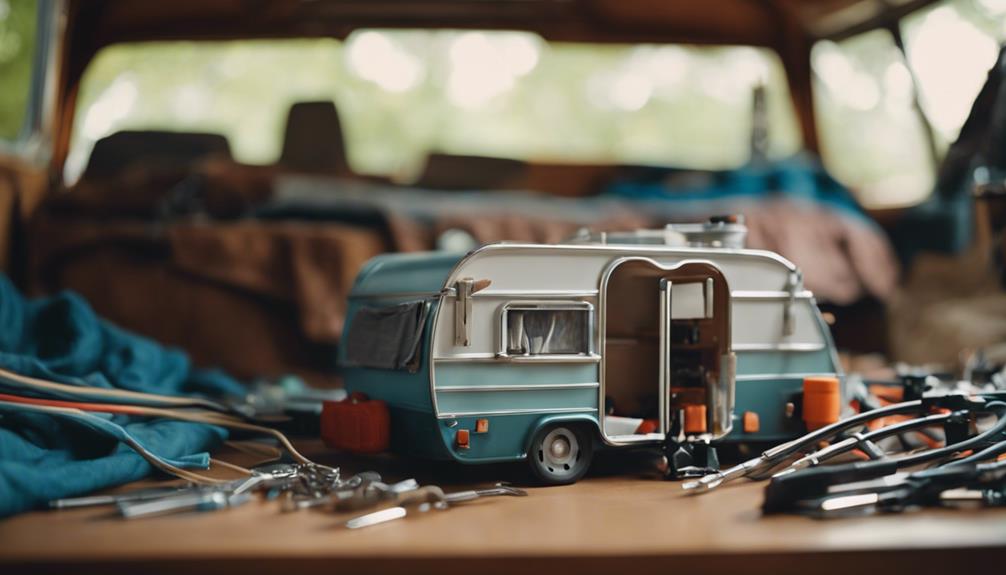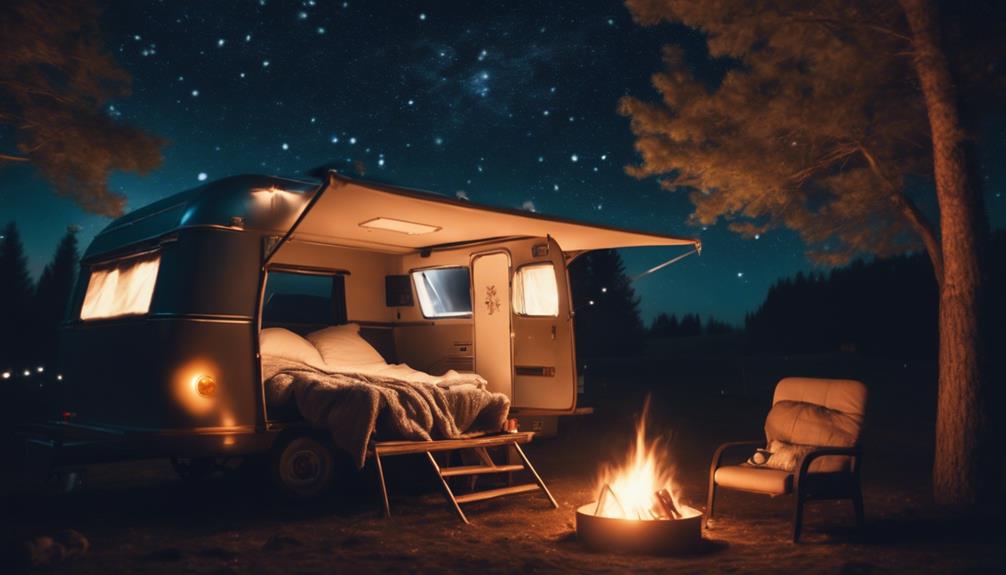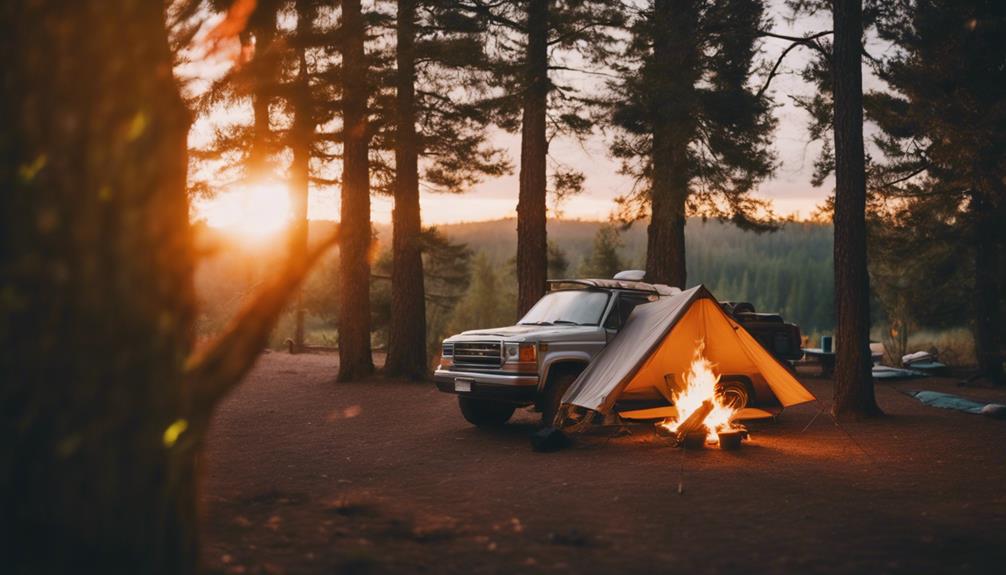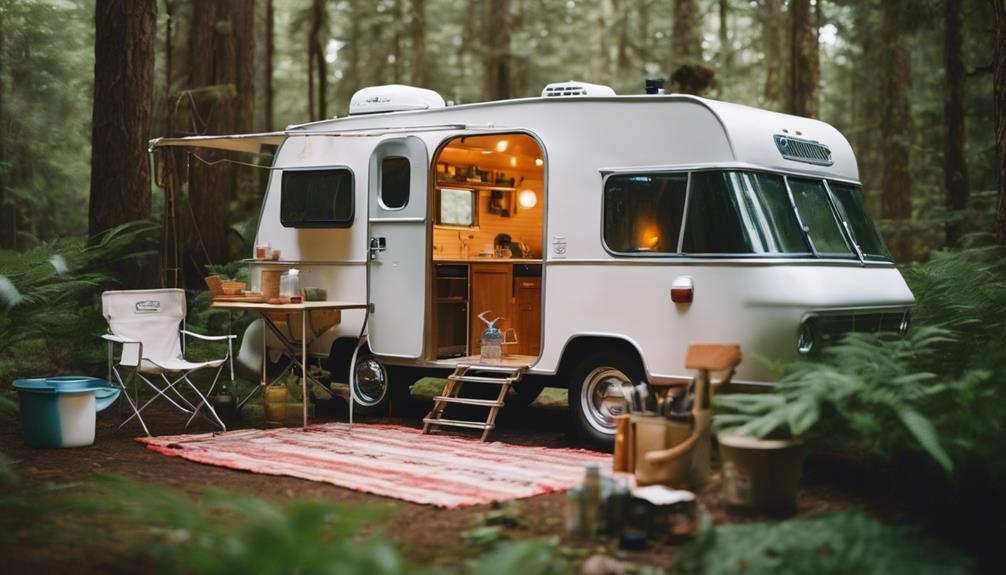Changing the cable on your pop-up camper is crucial for safe operation. Start by securing a level workspace and gathering your tools, like a socket set and pliers. Disconnect the battery for safety and remove any paneling to access the lift system. Detach the old cable carefully, noting its configuration. Thread the new cable through the pulleys and attach it securely to the crank assembly and lift arms. Adjust the tension evenly on both sides to guarantee smooth lifting. Regular checks and maintenance can extend the life of your lift system. There's plenty more to discover about this process.
Key Takeaways
- Begin by securing the camper, disconnecting the battery, and wearing appropriate personal protective equipment for safety during repairs.
- Remove obstructing paneling to access the lift system, ensuring the roof is safely lowered to relieve cable tension.
- Detach the old cable from the crank assembly and lift arms, taking care to note the configuration for reinstallation.
- Thread the new cable through the pulleys, ensuring no twists, and attach it securely to the lift arms and crank assembly.
Understanding Lift System Basics
The lift system of your pop-up camper relies on cables, pulleys, and lift arms to efficiently raise and lower the roof. Understanding how these components work together is essential for maintaining functionality.
The lift cables are particularly important; they bear the weight of the roof and can wear out over time. If you notice any fraying or damage, it's critical to replace them to prevent further issues.
Maintaining proper tension in the lift cables is key. Too much tension can lead to overcranking, which risks damaging the system. On the other hand, insufficient tension may prevent the roof from lifting correctly. You should familiarize yourself with the overcrank procedure, as it's designed to reset the compression level rather than hold the roof in place.
Regular inspections of the lift system will help you catch any signs of wear and tear early on. Keeping an eye on the cables and pulleys guarantees your camper's roof operates smoothly when you need it most.
Don't underestimate the significance of this maintenance; it can save you from severe damage and costly repairs down the line.
Tools and Materials Needed
When preparing to change the cables on your pop-up camper, gather essential tools and materials to guarantee a smooth process. Having the right equipment will make your repair work efficient and less frustrating.
Here's what you'll need:
- Socket set: For loosening and tightening bolts.
- Replacement lift cables: Confirm they match your camper's specifications.
- Wire cutter or cable cutter: To remove old cables without damage.
- Measuring tape: To verify that new cables are the correct length.
Additionally, a drill and a rivet gun can be helpful for securing new components to your pop-up camper.
Don't underestimate the importance of a well-maintained draw bar, as it plays a significant role in the functionality of your camper.
By collecting these tools and materials before you start, you'll set yourself up for success and enjoy a hassle-free cable replacement experience.
Safety Precautions Before Starting
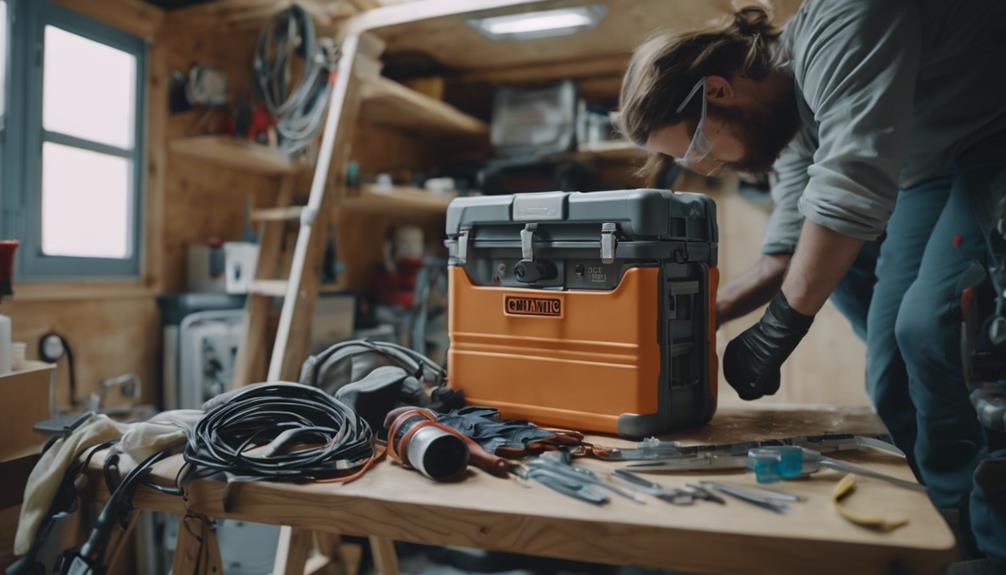
Before you start working on your pop-up camper, make certain you secure a level work area to prevent any accidents.
Don't forget to wear your personal protective equipment, like gloves and eye protection, to shield yourself from sharp cables.
Taking these precautions helps guarantee a safer and smoother repair process.
Personal Protective Equipment
Wearing proper personal protective equipment is essential to guarantee your safety while changing the cable on a pop-up camper. Before you embark on the job, make sure you're well-equipped to handle any risks that come your way.
Here's a quick checklist of items you should have on hand:
- Safety goggles: Protect your eyes from flying debris and sharp objects.
- Heavy-duty gloves: Prevent cuts and scrapes when handling cables and metal parts.
- Closed-toe shoes: Safeguard your feet from falling tools or components.
- Dust mask: Avoid inhaling dust and particles released during disassembly and repair.
Secure Work Area
To guarantee a safe environment while changing the cable on your pop-up camper, park it on a level surface and chock the wheels securely. This prevents any unwanted movement during your repair process.
Next, disconnect the camper's battery to avoid any accidental electrical issues while you're working on the lift system.
Before diving into the task, make certain you're wearing safety goggles and gloves. This protects your eyes and hands from sharp edges and debris that may arise during cable replacement.
Additionally, clear the work area of any obstacles and clutter. A tidy workspace not only helps you move freely but also minimizes the risk of accidents.
Lastly, keep a fire extinguisher nearby, especially if you're using tools that might generate sparks or if there are flammable materials involved.
Having these safety precautions in place guarantees you can focus on the task at hand without unnecessary distractions or dangers. By following these steps, you set yourself up for a safer and more efficient cable replacement process on your pop-up camper.
Accessing the Lift System
Before you access the lift system, make sure you've taken the necessary safety precautions to stabilize your camper.
Gather the tools you'll need, like a screwdriver and pliers, to remove any interior panels blocking your way.
With everything in place, you can confidently begin the process of getting to the lift mechanism.
Safety Precautions First
How can you guarantee safety when accessing the lift system of your pop-up camper? Following some essential precautions is key to preventing accidents and securing a smooth repair process.
Start by making sure your camper is parked on a level surface and securely stabilized. This will prevent any unexpected movement while you work. Disconnect the power source to the lift system to eliminate the risk of electrical hazards during repairs.
Next, protect yourself by wearing safety gloves and goggles to guard against sharp edges and potential injuries. Using the right tools, like a socket set and screwdrivers, will help you safely remove panels without damaging your camper.
Lastly, always have a helper on hand. This guarantees you have assistance when lifting and handling heavy parts, making the job safer and more efficient.
Here are some vital reminders to keep in mind:
- Always stabilize your camper before starting.
- Disconnect power to avoid shocks.
- Wear protective gear to prevent injuries.
- Use the right tools for the job.
Tools Required for Access
Gathering the right tools is essential for effectively accessing the lift system of your pop-up camper. You'll need a few key items to guarantee you can safely and efficiently perform the repairs. Here's a quick list of what you should have on hand:
| Tool | Purpose |
|---|---|
| Socket wrench set | To remove screws and bolts securing the lift assembly cover. |
| Flathead screwdriver | For prying off covers or panels obstructing access to cables. |
| Pliers | To grip and maneuver cables during the replacement process. |
| Drill with bits | For removing rivets if you need to replace or rebuild lift arms. |
Additionally, don't forget to wear safety goggles and gloves to protect yourself from sharp edges and debris. Having the right tools will not only make your job easier but also guarantee you work safely. Once you gather these essentials, you'll be well-prepared to access the lift system and tackle the cable replacement effectively.
Removing the Old Cable
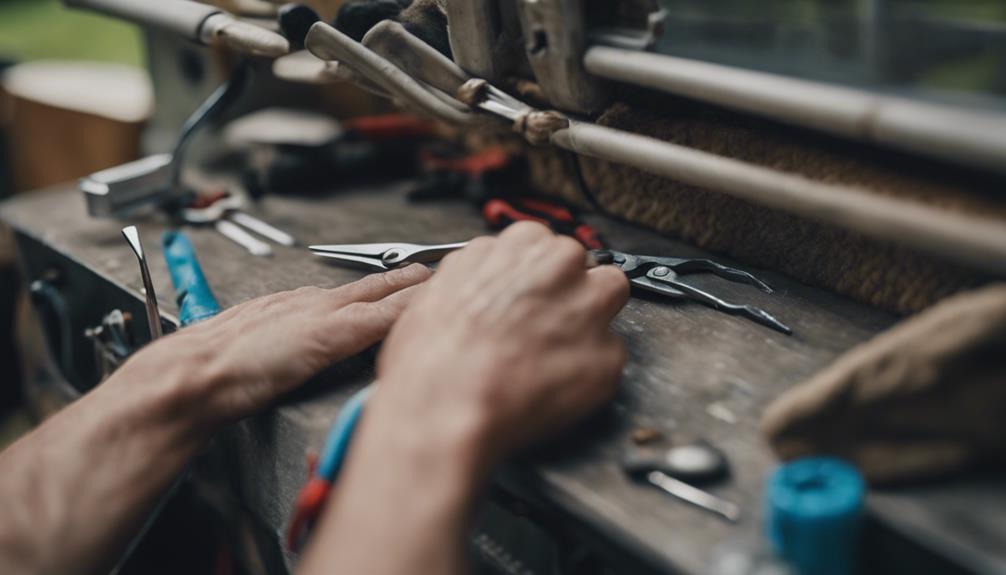
To start removing the old cable, confirm the pop-up camper roof is safely lowered so there's no tension on the lift cables. This is essential for your safety and the integrity of the camper.
Once you've verified the roof is down, remove any paneling or covers obstructing access to the lift cable system. These are typically found around the corners of the camper.
Next, carefully detach the old cable from the crank assembly by unscrewing or unbolting any fasteners that hold it in place. Pay attention to the connection points at the lift arms; unclip or unscrew the cable from these attachment points. Make sure to note how everything is configured for when you install the new cable later.
Finally, dispose of the old cable properly. Here's a quick reminder of why this process matters:
- Safety first: Prevent future mishaps.
- Peace of mind: Guarantee reliable lift operation.
- Cost-effective: Avoid costly repairs later.
- Adventure awaits: Get back to camping!
With these steps, you're well on your way to a successful cable replacement.
Installing the New Cable
Once the old cable is removed, you can start installing the new cable to make certain your pop-up camper operates smoothly.
First, make sure the camper roof is securely supported; this stability is vital to prevent accidents while you work.
Next, carefully detach the old cable from the lift arms and crank assembly, taking note of how it was routed. This will help you install the new cable correctly.
Now, thread the new cable through the pulleys and around the designated points in the lift system. It's important to maintain tension and avoid any twists in the cable during this process.
Once you've routed it properly, attach the new cable to the lift arms and crank assembly using the appropriate fasteners. Confirm all connections are tight and secure to prevent any future failures.
Adjusting Cable Tension

Adjusting cable tension on your pop-up camper is vital for guaranteeing the lift system operates smoothly and evenly. To start, locate the tension adjustment point near the lift mechanism, where the cables connect to the lift arms. It's important to have equal tension on both sides to avoid uneven lifting, which can cause further damage.
Here's how to adjust the cable tension:
- Feel the satisfaction of a well-functioning lift system.
- Prevent the frustration of getting stuck mid-lift.
- Enjoy the peace of mind knowing your camper is safe.
- Experience the joy of effortless setup at your favorite campsite.
Grab a wrench and loosen the tension adjustment nut. This allows you to either tighten or loosen the cable for proper tension. After making adjustments, manually test the lift system to confirm it's operating smoothly. Don't forget to secure the adjustment nut back in place.
Lastly, make it a habit to check the cable tension before each use. This simple step will help maintain peak performance and prevent potential lift system failures, guaranteeing your camping trips remain enjoyable and hassle-free.
Testing the Lift Mechanism
Before replacing the lift cable, it's essential to test the lift mechanism for any signs of resistance or unusual noises. Start by verifying that the lift mechanism is completely disengaged. This precaution prevents any accidental movement while you're working.
Next, manually crank the lift to see how it operates. Pay attention to any resistance; if you feel tight spots or hear strange sounds, it could indicate problems with the lift arms or the cable system itself.
Take a close look at the cables too. Inspect their entire length for any fraying or signs of excessive wear, as damaged cables can greatly impact the lift mechanism's performance. Additionally, check that the lift arms are straight and functioning properly. Bent arms can lead to improper cable tension, resulting in further complications down the line.
After you've replaced the cable, it's critical to perform a functional test. Crank the mechanism up and down several times to verify everything operates smoothly and that all components are properly aligned.
This testing step is fundamental to confirm that your repair was successful and that your pop-up camper is ready for use.
Maintenance Tips for Longevity
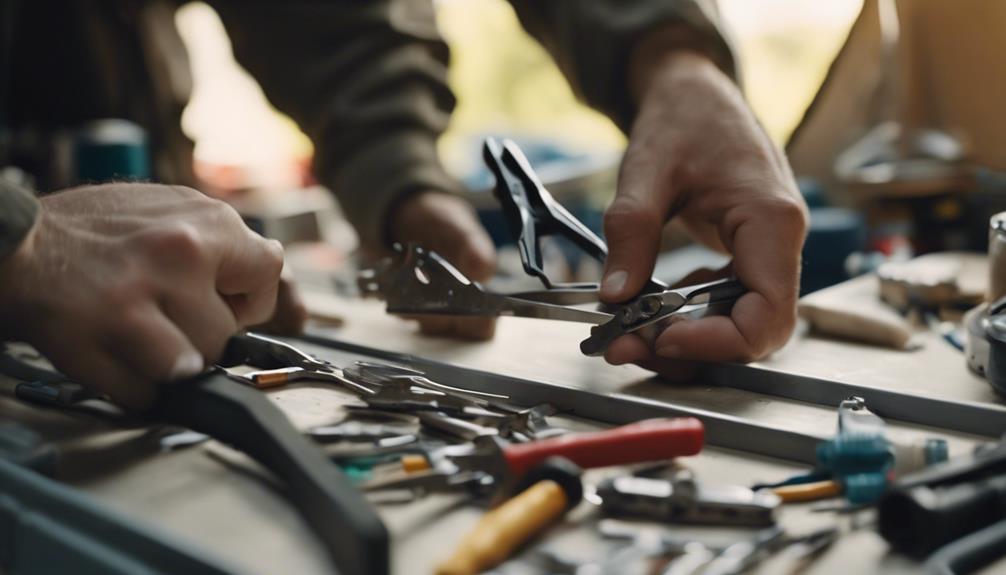
To keep your pop-up camper's lift system in top shape, regularly inspect the lift cables for any fraying or signs of wear. Early detection can save you from unexpected breakdowns and costly repairs.
Additionally, lubricate the lift system components, including pulleys and cables, at least once a season. This simple step guarantees smooth operation and reduces unnecessary wear.
Always follow the manufacturer's guidelines for the overcrank procedure to prevent severe damage to the lift system. When you're not using the camper, store it in a dry, sheltered area to protect it from weather-related damage. This practice can greatly extend the life of your lift system.
Lastly, keep the camper's lift system clean by removing debris and dust. Buildup can lead to operational difficulties and increase maintenance needs.
Here are some emotional reminders to keep in mind:
- A smooth lift means more adventure!
- Preventing wear means safer travels.
- Regular checks give peace of mind.
- Caring for your camper enhances memories.
With these tips, you'll enjoy your pop-up camper for many seasons to come.
Frequently Asked Questions
How to Repair the Canvas on a Pop-Up Camper?
To repair the canvas on your pop-up camper, inspect for damage, clean the area, and apply a fabric patch with waterproof adhesive. Use seam sealant for any frayed seams to prevent moisture leaks.
Can Changing the Cable on a Pop-Up Camper Lead to Dismantling the Camper?
If you are considering changing the cable on your pop-up camper, it’s important to follow a popup camper dismantling tutorial to ensure safe and proper dismantling of the camper. Following the tutorial will guide you through the process and help you avoid any potential issues that could result from improper dismantling.
Conclusion
So, you've tackled the wild world of pop-up camper cable replacement—congratulations!
You've now earned the title of “Master of the Lift” (or at least the 'Person Who Can Fix a Cable'). Just remember, maintaining that lift system is like keeping a toddler happy: it takes regular attention and a sprinkle of patience.
If it squeaks or doesn't lift right, don't panic! You've got the skills to save the day—just don't let it become a dramatic camping saga!

